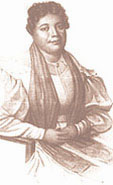- ʻAuhea ʻo ka lani lā
- Aia i ka heʻe nalu
-
- Heʻe ana i ka lala lā
- Hoʻi ana i ka muku
-
- A ka nalu o hoʻeu lā
- Eu hoʻi aʻe kāua
-
- A pae aʻe Kaimu lā
- Hoʻomu nā kanaka
-
- ʻAuʻau i ka wai lā
- Aʻo Waiʻakolea
-
- Luʻu aku a ea mai lā
- Kanaenae o ka lani
-
- Haʻina mai ka puana lā
- No Lunalilo no he inoa
He Inoa no Lunalilo
|
-

King William
Charles Lunalilo
-
-

-
High Chiefess
Miriam Auhea Kekauluohi
|
- Where is the royal
chief?
- There surfing
-
- Surfing on the long wave
- Returning on the short
wave
-
- On the hoʻeu wave
- We both return
-
- And land at the sea of
Kaimu
- Where the natives gather
-
- We bath in the fresh
water
- The pond of Waiʻakolea
-
- We dive and surface
- A prayerful chant for the
chief
-
- Tell the refrain
- Lunalilo is the name
-
- In the name of Lunalilo
|
| Source: Lunalilo by Peter Galuteria,
Na Mele Hula by Nona Beamer - Hoʻeu means a frothy,
stirring, whirlpool wave. Kaimu is a famous surfing
beach. Waiaʻkolea, water of the akolea fern, is a fresh
water pond at Kalapana. Luʻu is a diving style with a
leaf held in the mouth and covering the nose. This chant
honors William Charles Lunalilo, 6th ruler of Hawaiʻi and
his surfing exploits in the Puna district of Hawaiʻi.
Born January 31, 1835, in a coral house at Pohukaina, he
was a prince of high rank; the son of High Chief Charles
Kanaʻina and High Chiefess Miriam Auhea Kekauluohi (the
thriving growth), the 3rd highest ranking chiefess at
that time. After the death of Kamehameha I, her uncle,
she took the name Auhea (where has he gone). Hawaiian
tradition traces genealogy thru the mother. When a name
for the prince was about to be selected, his mother
chanted: "I luna, i luna, i lunalilo, the highest, the
highest, the highest of all". Luna (high) lilo (lost)
means so high up as to be lost to sight. He was also
named for King William IV of Britain, a great friend of
Hawaiian royalty. Educated at the Chief's Childrens
School, he was a good student, winning many scholastic
awards. His keen memory, love of
his people and a deep sense of justice were among his
best assets. Upon the death of King Kamehameha V,
Lunalilo was nominated for king. His birthright was
enough to claim the throne, but he wanted the people to
choose their ruler. His handsome features, gracious
manners and intelligence endeared him to all and he was
affectionately called Lokomaika`i, (merciful or
gracious). He was elected overwhelmingly by the people,
unanimously by the legislature and installed as king at
Kawaihao Church, January 9, 1873. Noted for
simplicity, he sat on the throne covered with the feather
cape, symbol of Hawaiian Royalty. This was the ancient
act of coronation. His reign began in the middle of an
economic depression, but the greatest problem he
inherited was the enforcement of the law to prevent the
spread of leprosy. His pain for lepers separated from
their families and friends and his commitment to protect
the uninfected population weighed deeply upon his
conscience. The arrival of Father Damien in 1873, was one
answer to his fervent prayer. Unable to cope with the
changing times and deeply burdened by the dwindling of
his native people, he became addicted to alcohol. Feb. 3,
1874, the King died of tuberculosis at his home in
Waikīkī. He was 39 years old. His was the briefest reign
of all, 1 year and 25 days, but the most democratic and
receptive to American influence. His lasting legacy is
Lunalilo Home, a care home for aged and destitute
Hawaiians, founded in 1881.
|

